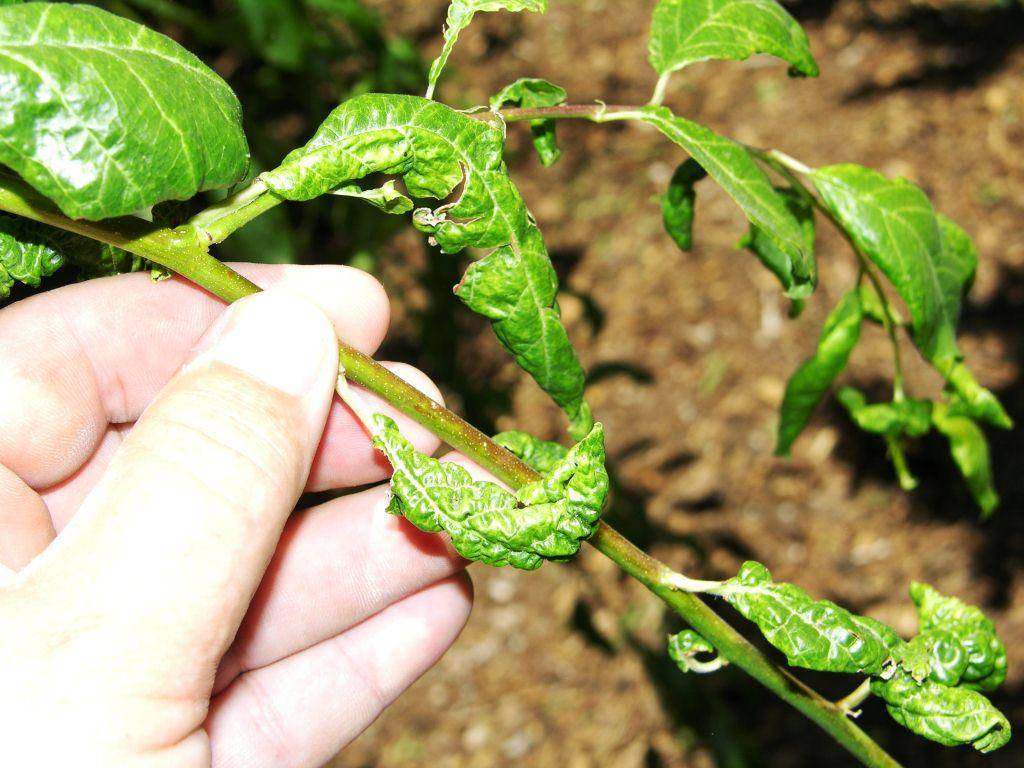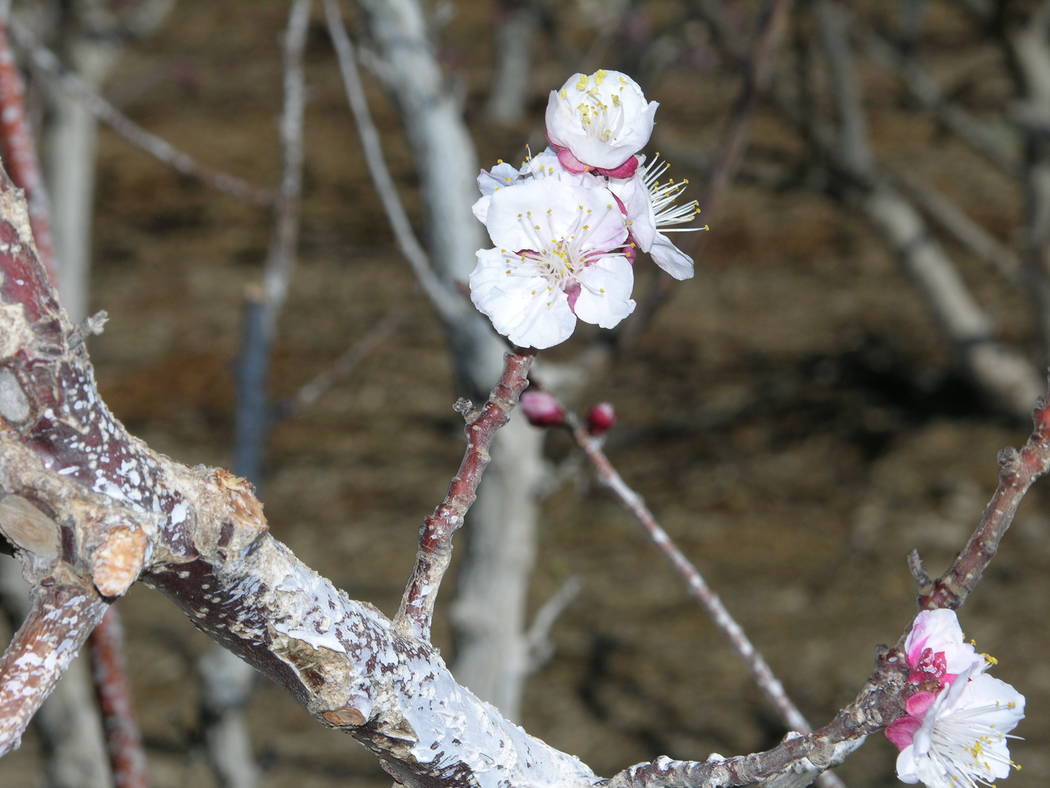Controlling ant nests can help stymie spread of aphids
Aphids are on fruit trees, roses, winter vegetables and other landscape plants. They love cool nights but warm daytime temperatures for feeding and breeding. Their feeding causes new leaves to curl on the edges and glistening, sugary sap on leaves.
Opening these curls with your fingers, you will see adults and “babies.” The mother aphid survived the winter on this plant just below the soil or on neighboring weeds, then migrated to the new growth when it appeared.
Mother aphids don’t need a mate. They can have babies on their own.
If protected inside leaf curls then they are difficult to control without chemicals, called systemic insecticides, applied to the soil and transported to the leaves from the roots. Personally, I would not apply these types of chemicals to plants that provide food such as vegetables or fruit trees. They are fine if used on ornamentals such as roses, shrubs and trees.
Other organic options are to make weekly applications of soap and water sprays or use oils. Neem oil is safe to use on all vegetables or fruit trees now if they are not flowering. Or apply dormant oil used during the winter on fruit trees and ornamentals.
Dormant oils are OK to use until the weather gets hot. Never apply soap and water, oils or any insecticide when plants have flowers. Wait until the flowers have passed and then apply them to protect honeybees.
Some ants pick up aphids and distribute them to tender, new leaves for feeding. They are the cattle ranchers of the insect world. You will see the entrance to ant nests being created now in dry soils near to where aphids are feeding. These are 4- to 6-inch-diameter mounds with a hole in the center.
If you find an entrance to an ant nest you will probably find aphids feeding in nearby plants. Ants love the sugary sap that comes from the aphids. So do bees. Ants protect aphids if they are threatened and may even transport them to safety.
Controlling ant nests helps control aphids. My favorite method for controlling ants is to lightly sprinkle a poisonous bait they take back to their underground nest.
Products like Amdro work within 24 hours when applied to the entrance of a nest provided the entrance is dry when it is applied. Read the label of any pesticide before applying it.
Q: We have an orange tree in our backyard with only two fruit. I noticed there are two different looking branches. One has bigger leaves with flowers and the other one has smaller leaves and thorny branches but it is getting bigger and fuller. Is my tree going to produce fruit or not?
A: Citrus trees purchased from nurseries, like most other fruit trees, are two trees combined into one. They are grafted together when they are very young. One tree provides good quality roots but poor quality fruit. The second tree provides the top of the tree which has good quality fruit.
A common tree grafted to citrus is sour orange. It is very tolerant of winter freezing temperatures. The fruit looks beautiful but it is extremely sour; too sour to eat fresh.
Sour orange is grafted onto many wonderful citrus trees that provide high-quality fruit. Most are more sensitive to winter low temperatures, while the sour orange roots are not. If you look closely, you will see a crook or dogleg where the two trees are joined together.
Sour orange, when it is young, may sprout suckers that grow from this dogleg. If they are not removed but allowed to grow, they produce very vigorous stems that are very thorny. They eventually dominate the top which produces good fruit and perhaps even cause it to decline and die.
Sometimes the more winter-tender top may die while the sour orange roots will sucker and produce a vigorous tree with horrible but beautiful fresh fruit. These thorny citrus suckers eventually replace the more desirable citrus tree.
The solution? Remove the sour orange sucker where it grows from the trunk. Make sure your pruning saw or shears is sharp and sanitized. Do not lay it on the ground after it has been sanitized where there are soil diseases that can harm the tree. There is no need to paint the wound but allow it to heal on its own.
Q: Due to my bad shoulders I would like to have a peach tree that does not grow so high, and I would like for it to be a freestone. Is there one which you would recommend?
A: The type of tree you’re talking about is going to be a genetic dwarf peach sometimes called a miniature peach tree. It produces full-sized peach fruit but stays small. The fruit is OK, but it is not going to be as consistently good as some of the other larger peach trees. Look for names such as Bonanza or El Dorado or Pix Zee.
Q: We have a Majestic ash tree that was planted a few years ago. It was doing extremely well until a year ago. All the new growth is just tiny bits of mostly dried green on the ends of the branches. A few leaves have appeared, but mostly it’s just the little spiky tips. The older leaves are just fine. It just won’t sprout new growth. Any help?
A: I don’t know this variety of ash but sometimes we collectively call this group of ash shamel or evergreen ash. It is evergreen, keeping its leaves all winter long, but that’s only in warmer climates.
When the temperatures drop into the 20s it drops its leaves and becomes deciduous. When the temperatures approach 20 degrees F, it is possible they can have winter dieback or cold damage. This may be what you are seeing in your tree.
As the tree gets older it should be more tolerant of freezing temperatures. The only other possibility is chemical damage from weed killers applied to close to the tree or during a time of heat and wind. If this has been winter damage and the tree has not been damaged too badly, it will come back very strong this growing season. Right now it’s early in the season so give it a chance.
Q: I’ve noticed over the past few years my apricot tree produces a decent number of flowers in spring but few fruit because the flowers drop from the tree as if they weren’t pollinated. I do notice bees pollinating the flowers. I was wondering if the cause could be not enough water or a need for early fertilizing of the tree?
A: If the tree appears to be healthy and producing at least 12 to 15 inches of new growth every year, I don’t think it’s a fertilizer problem. However, it would not hurt to apply a complete fertilizer or a ring of compost around the tree to provide plant nutrients just in case.
Some apricots have flowers more tolerant of freezing cold weather than others. We see apricot flowers produced through February and into early March. If there is a late freeze and the tree produces flowers not tolerant of these temperatures, they will drop.
If the tree has a lack of water, it may cause flowers and small fruit to drop. I recommend irrigating once a week starting Feb. 1 and covering the soil around the tree with 4 to 6 inches of wood chip mulch.
There are a few apricots that need a pollenizer tree but most do not. Yours may be one that needs a pollenizer tree. If this continues for two to three years in a row, I would get rid of the tree and put in a different variety. Apricots are wonderful fruit trees for our climate and nearly all produce fruit.
Bob Morris is a horticulture expert living in Las Vegas and professor emeritus for the University of Nevada. Visit his blog at xtremehorticulture.blogspot.com. Send questions to Extremehort@aol.com.
























